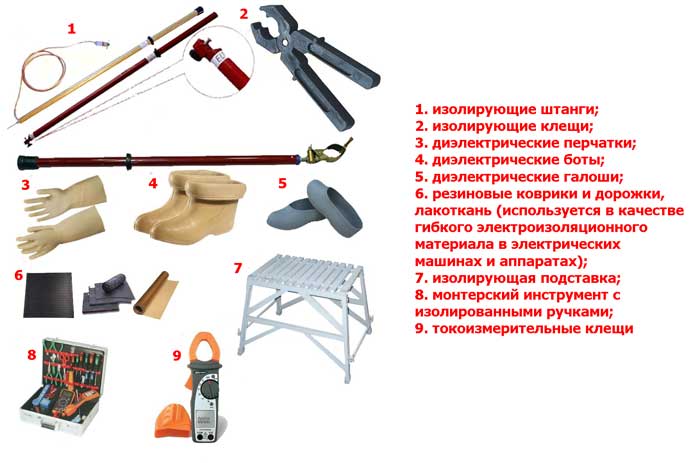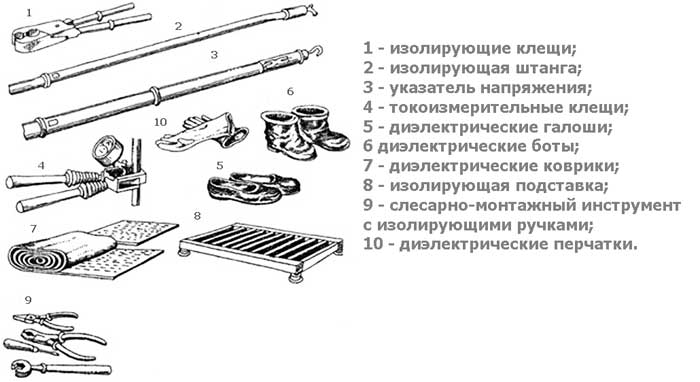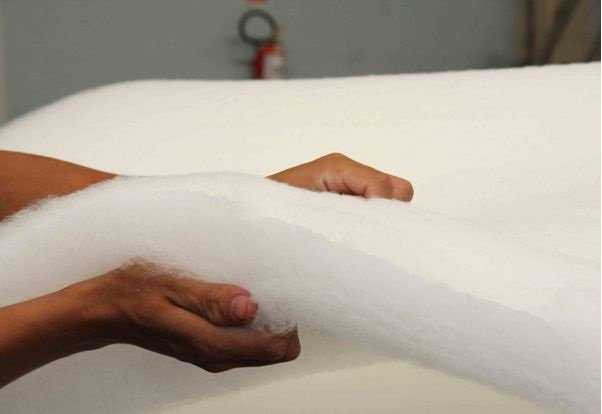Electrical protective equipment. Brief classification and description
Electricity is almost always unpredictable. After all, it is impossible to feel it by smell or touch. And the consequences of defeat are very deplorable and can even lead to death. To avoid this, you need to use electrical protective equipment.
Human negligence and carelessness are the main causes of electric shock. To prevent this, you need to follow all safety rules and be very careful. To prevent accidents at enterprises, the following protective methods are used:
- Electrical protective equipment. Almost all of these are dielectric tools and accessories.
- Electrical field protection tools.
- Individual protection means.
The danger of electric shock is determined by the following factors:
- Electric - voltage and current strength, frequency, electrical resistance of a person.
- The state of the environment. For example, air humidity.
- Not electric - human features.
Consider what protective equipment is used in electrical installations to prevent electric shock to a person.
Electrical protective tools and devices are a small part of technical protection measures during work from electric shock.
It is also a means of protection in electrical installations, which is used to prevent electric shock and to ensure the safety of employees when performing repairs in electrical devices.
Protective measures against electric shock are divided into 2 groups:
- Basic.
- Auxiliary.
The main electrical protective equipment is insulation methods.
They are designed to withstand operating voltage over a long period. They are used if there is a need to perform a task under voltage.
Auxiliary tools for an electrician are additional means of protection in electrical installations that cannot be used independently and they go as an addition to the main ones. Used to protect the employee from step voltage. For example, dielectric rugs.

Basic and additional methods of protection in electrical installations together ensure the full safety of an employee at the workplace, when performing a task with various electrical installations.
Subsidiary protections are used in conjunction with the main ones.
Electric shock protection devices are classified according to voltage class:
- up to 1000 (V)
- above 1000 (V).
Each tool has its own class of protection against electric shock. It is applied to the instrument itself. This means that this tool can only be used at a certain voltage. Improper use can lead to unpleasant consequences.
Basic electrical protective equipment above 1000 V
The main insulating voltage protective equipment is used for work under voltage, and ensure complete safety of human life. Consider what technical means against electric shock are used most often (category above 1000 V):
- All types of insulating rods. Used to install and dismantle various parts. They also help to release the victim. They can only be used indoors. If the renovation will take place outside the building, it should not be wet. Please note that gloves must be worn when using the barbell.
- Insulated pliers. With their help, the installation or dismantling of fuses is carried out. They are used strictly for their intended purpose and taking into account how much the insulation is designed for. The clamp size depends on the voltage. When working, you must wear glasses and gloves. The pliers must be suitable for the degree of protection.
- High voltage indicators. Before commencing any work, the electrician must determine if the equipment is energized. Its presence or absence is determined using a pointer.
- Measuring devices.

Additional electrical protective equipment above 1000 V
In addition to the basic equipment, additional protection is needed for a full and safe work of an electrician. Additional means of electrical protection over 1000 (V) include:
- Dielectric gloves, galoshes, rugs, shield or stand, cap and pads. Gloves protect the hands of the worker from electric shock. in electrical installations, dielectric galoshes are used to protect the worker from the current that may pass in the base. The mat has the same function as galoshes. Particularly relevant if the floor is damp. The stand is required when working above 1000 (V). They protect against the action of the current, if there is one at the base. Dielectric caps and pads are PPE, which are used to avoid short circuits.
- Potential equalization bars. Used to transfer stress.
- Ladders made of fiberglass. They are safe as no current flows through them.
Basic electrical protective equipment up to 1000 V
The main isolating protective equipment against voltage in many respects repeat the additional protective equipment over 1000 (V). Basic electrical protective equipment up to 1000 (V) include:
- Insulating rods. Avoid electric shock.
- Seamless dielectric gloves. Protect the electrician's hands from injury.
- Insulated pliers and electric pliers. They are essential for safe working with the instruments. The second version of the tick helps to determine the voltage. If an electrician uses a pliers, they should wear gloves and goggles.
- Low voltage indicators.
- Insulated hand tools. It is required for various jobs. These include a locksmith's tool, on the handles of which there is insulation. However, the thickness of the insulation depends on the type of task being performed.
The considered electrical protective equipment in electrical installations up to 1000 (V) guarantee the necessary safety of the employee.
Additional electrical protective equipment up to 1000 V
Additional electrical protective equipment in electrical installations up to 1000 (V) is necessary for the complete set and protection of the electrician. Technical methods of protection against electric shock include:
- Insulating base, caps, covers and linings. The stands are placed on the floor, where electricians will work.
- Dielectric mat. Used like a stand. It is more convenient to use. But the rug will not work if there is water on the floor. Inspection and inspection should be carried out periodically before use, as it may be damaged.
- Insulating fiberglass (dielectric) ladders and ladders.
- Dielectric galoshes.
- Potential leveling and transfer rods.
Protective equipment against electrical fields
When working in electrical installations, it is possible to be injured not only by electric shock, but also by an electric field. The action of an electric field does not have such a detrimental effect on human health as an electric shock. However, prolonged exposure to an electric field negatively affects the human nervous system. Consider the second type of protection when working in electrical installations from an electric field.
- An individual kit must be provided for the electrician. Which, protects from the field when working in an open switchgear and on the potential of an overhead power line. It includes a suit and additional equipment
- Shielding devices. They prevent the influence of the electric field on a person. They are necessary for the repair and maintenance of electrical equipment.
- There must be warning signs and posters on the territory. They have different functions. Some inform, some warn about safety.
- Portable grounding. Used to ensure the safety of an electrician.
Individual protection means
The last type is the PPE of the electrician. Personal protective equipment against electric shock is used by only one person. Personal protective equipment for an electrician includes:
- Glasses. Protects eyes from damage by small particles.
- Fencing.
- Mittens.
- Belts and ropes.
- Plastic helmets.
- Respirators and gas masks.
Description of the most common additional and basic remedies
Gloves are considered the most common inventory. They are used for all work. Before checking, they must be checked for leaks. Gloves that have not passed the test are prohibited.
Fitting and assembly tools are used for work at a voltage not exceeding 380 V. Their handles are insulated with plastic handles. They have a protective function.
Voltage indicators are equipped with a special indicator. A luminous indicator indicates the presence of voltage in the equipment.
Insulating pliers are made of plastic only. They mount and dismantle various elements, most often fuses.
Equipment check
Each inventory must have appropriate documents, which must contain the following information: name, manufacturer, date of manufacture and test period. The last point is the most important.
All protection methods are tested upon entry into service. The rest of the checks and their number depend on the type of protective equipment. GOST and TU indicate the conditions and time of testing, the frequency of testing and inspections. For example, ladders are inspected every six months, and gloves are inspected before each use.
General rules for the use of protective equipment
- All fixtures must be inspected and tested.
- If the device is dirty, or even slightly damaged, its service life has come to an end, the insulation is damaged, then its use is prohibited. Since during the execution of the task, a person may suffer from electricity. Such devices are taken out of service.
- All appliances must be dry. For repairs outdoors, in wet weather, there are other methods of protection.
- All instruments must be clean. This primarily applies to gloves and galoshes.
- Each tool and protection device is designed to operate at a different voltage. This class is indicated on the body of the instrument.
All PPE, according to safety rules, must be located in rooms with an electrical installation as inventory or must be at each team, issued for individual use.
The responsibility for the inventory and its timely delivery is borne by the head of the workshop and the foreman of the site.
Every electrician should be equipped with electrical protection equipment depending on the type of work being performed. Please note that all tools must be inspected before starting work and when energized. Before each work, the serviceability of the tools is checked.
- Rules for the use of electrical protective equipment when carrying out work in electrical installations
- How to sew fleece mittens
- Protective equipment in electrical installations
- Computer glasses: which is better to choose
- How to wash clothes with Thinsulate insulation
- Training in electrical safety, labor protection, ecology, electrical safety, fire-technical minimum, first aid to victims of the courses
- Protective equipment in electrical installations up to and above 1000 Volts
- What is fleece fabric, where is it used and how to care for it
- Personal protective equipment
- What is this fabric?
- Thinsulate
- Insulation thinsulate: reviews, properties
- Twill (fabric): description, application, photo
- Polyester - what is this fabric
- The meaning of the title of Platonov's story "In a wonderful and furious world
- An example from fiction lyubov turgenev asya
- Devushkin Makar Alekseevich Several interesting compositions
- The place of the first meeting of the master and margarita
- Solzhenitsyn and the audiobook "One Day in Ivan Denisovich"
- Types of characters in the fairy tale "Cinderella









